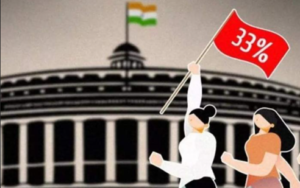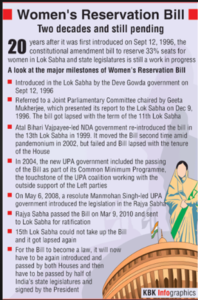Women Reservation Bill.
Relevance
- GS 2: Government Policies and Interventions for Development in various sectors and Issues arising out of their Design and Implementation.
- Tags: #WomenReservationBill #GenderEquality #WomenInPolitics #EmpowerHer #InclusivePolitics #EqualRepresentation #WomenLeadership.
Why in the news?
On Wednesday evening, the Lok Sabha approved the Constitution (128th Amendment) Bill, i.e., Women’s Reservation Bill with an overwhelming majority of 454 votes. This historic legislation, known as the Nari Shakti Vandan Adhiniyam, paves the way for the allocation of 33% of seats to women in both the Lower House of Parliament and state legislative assemblies.
Main Features of the Women’s Reservation Bill
- Reservation Percentage: The Bill proposes 33% reservation for women in the Lok Sabha (House of the People) and Assemblies of State and National Capital Territory of Delhi.
- Reservation within SC and ST Seats: The reservation also applies within the seats already reserved for Scheduled Castes (SC) and Scheduled Tribes (ST). This means that within the existing SC/ST reserved seats, 33% will be reserved for women belonging to these categories.
- Duration: The Bill suggests that the reservation will remain in effect for 15 years from the commencement of the proposed enactment.
- Seat Rotation: Seats reserved for women will be rotated after each delimitation exercise. Delimitation is the process of determining the boundaries of constituencies to ensure equal representation.
Process for the Bill to Become Law
- Passage in Parliament: The Bill needs to be passed by both houses of Parliament by a special majority.
- This special majority means that it should be supported by a majority of the total membership of each house and by a majority of not less than two-thirds of the members present and voting.
- State Ratification: According to Article 368 of the Indian Constitution, the Constitution Amendment Bill (like the Women’s Reservation Bill) requires ratification by at least 50% of the States because it affects their rights.
Historical Background
Rajiv Gandhi’s Initiative (1989)
- Former Prime Minister Rajiv Gandhi introduced the concept of women’s reservation in elected bodies by proposing a Constitution Amendment Bill in 1989.
- Although it passed in the Lok Sabha, it failed to gain approval in the Rajya Sabha.
P.V. Narasimha Rao’s Efforts (1992-1993)
- Prime Minister P.V. Narasimha Rao reintroduced Constitution Amendment Bills 72nd and 73rd in 1992 and 1993, which reserved one-third of seats and chairperson posts for women in local bodies.
- These bills became law, resulting in a significant number of elected women representatives in panchayats and nagarpalikas.
Deve Gowda’s Attempt (1996)
- In 1996, the United Front government led by Deve Gowda introduced the 81st Constitution Amendment Bill in Lok Sabha for reservation of women in Parliament, but it did not receive approval.
Vajpayee Government’s Efforts (1998-2003)
- The Atal Bihari Vajpayee-led NDA government attempted to pass the Women’s Reservation Bill in the 12th Lok Sabha between 1998 and 2003 but faced repeated setbacks.
- In 1999, the NDA government made another attempt by reintroducing the bill in the 13th Lok Sabha. Subsequently, the bill was introduced twice more in Parliament in 2003.
Manmohan Singh’s UPA Government (2004-2010)
- The bill gained momentum during Manmohan Singh’s UPA government.
- It was tabled in the Rajya Sabha in 2008, and after going through various stages.
Geeta Mukherjee Committee
Five of the seven recommendations made by the committee in 1996, were included in this version of the Bill. These recommendations included
- Reservation for a period of 15 years.
- Sub-reservation for Anglo Indians.
- Reservation in cases where the state has less than three seats in Lok Sabha (or less than three seats for SCs/STs).
- Reservation for the Delhi assembly.
- Changing “not less than one-third” to “as nearly as may be, one-third.
Historic Passage in Rajya Sabha (2010)
- On March 9, 2010, the bill achieved a historic milestone when it was passed in the Rajya Sabha with an overwhelming vote of 186-1 after extensive debate.
- However, the bill’s journey took another setback when it reached the Lok Sabha and never progressed.
- The dissolution of the House in 2014 led to another lapse.
The Urgent Need for Change
Stalling Progress
- Despite its female population size, India has lagged in empowering women politically.
- Crimes against women have risen, women’s economic participation remains low, and the sex ratio at birth are skewed.
Benefits of Political Reservation
- Research shows that political reservation for women enhances representation of women-related issues and overall political participation by women.
- Many countries have successfully implemented electoral apportionment for women.
Current Gender Disparities
- In contrast to global averages, the 17th Lok Sabha has only 15% women MPs, with Rajya Sabha even lower at 14%.
International Comparison
- India’s representation of women in Parliament lags behind many countries.
- Rwanda leads with 61% female representation, followed by South Africa (43%) and Bangladesh (21%).
- India ranks 144 out of 193 countries in the representation of women in Parliament, according to the Inter-Parliamentary Union.
Declining Executive Representation
- The share of women ministers in the central executive dropped from 23% in 2019 to a mere 9% in 2021.
Addressing Gender-Based Discrimination
- Patriarchal Norms: Deep-rooted patriarchy has limited women’s political participation.
- Breaking Barriers: The bill seeks to break these barriers and challenge gender discrimination.
Ensuring Inclusivity
- Diverse Perspectives: Women’s participation brings diverse perspectives to policymaking.
- Inclusive Governance: It promotes more inclusive and representative governance.
Impact of the Women’s Reservation Bill
Political Impact
- Increased Representation: The bill would significantly increase women’s representation in Parliament and State Assemblies.
- Policy Focus: It may lead to the prioritization of gender-specific policies and women’s issues.
- Gender-Sensitive Legislation: Higher female representation is likely to lead to more gender-sensitive laws.
- Enhanced Participation: Women’s political participation is a human right and critical for addressing gender issues effectively.
Social Impact
- Empowerment: Increased political representation can empower women socially and challenge traditional gender roles.
- Role Models: Women leaders can serve as role models, inspiring future generations.
Economic Impact
- Economic Empowerment: Women’s participation in policymaking can lead to economic empowerment, with a focus on livelihood opportunities.
- Gender Budgeting: It may facilitate gender-sensitive budgeting and resource allocation.
Global Implications
- Inspiration for Other Nations: India’s Women’s Reservation Bill can serve as an example for other countries seeking to enhance gender equality in politics.
- Diplomatic Impact: Increased women’s representation may impact India’s diplomatic engagements.
The Women’s Reservation Bill is a crucial piece of legislation aimed at increasing the political representation of women in India. Despite its long and complicated history, it remains a critical step towards addressing gender inequality in the country. The successful passage and implementation of this bill could significantly impact the composition of India’s political landscape, leading to greater inclusivity and responsiveness to women’s concerns.
Source: The Hindu, Indian Express, Livemint.
Mains Question
Explain the objectives and historical journey of the Women’s Reservation Bill in India, highlighting its significance in addressing gender disparities in political representation?





